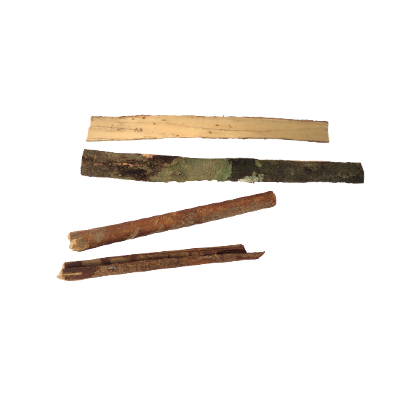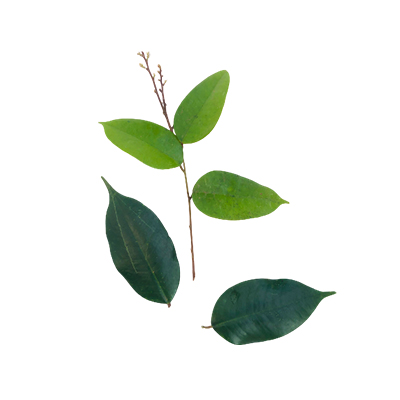Giam
Cotylelobium melanoxylon (Hook.f.) Pierre
Dipterocarpaceae
Location in our garden
Principal



Synonym
Cotylelobium beccarianum (F.Heim) F.Heim
Cotylelobium harmandii (F.Heim) F.Heim
Cotylelobium leucocarpum Slooten
Habitus
Trees. An emergent tree with a rather small, hemispherical crown that can grow up to 50 m tall
Part Used
Leaves
Bark
Growing Requirements
Full Sunshine
High Rainfall
Habitat
Forest
Coastal
Overview
Giam usually occurs scattered in the forest, and although regeneration may be plentiful, it takes a very long time for trees to reach a commercially interesting size. Giam has a specific geographic distribution range, this plant is naturally found in Borneo, Malaya, Sumatera, and Thailand.
Vernacular Names
Khiam khaao (Thailand), Resak tempurong (Malaysia), Resak Hitam (Brunei)
Agroecology
A plant of the moist to wet, lowland tropics, where it is found at elevations up to 300 m. It grows best in areas where annual daytime temperatures are within the range 22-34 °C, but can tolerate 12-38 °C. It prefers a mean annual rainfall in the range 2,100-2,700 mm, but tolerates 1,800-3,000 mm. Grows best in a sunny position. Prefers dry, often sandy or loamy soils and moist podzols in the wild. Prefers a pH in the range 4-4.5, tolerating 3.7-5.
Morphology
- Bole - frequently twisted with low buttresses. It can be unbranched for up to 30 m and up to160 cm in diameter.
- Leaves - simple, alternate, ovate-lanceolate, 5-10 cm × 2-6 cm,the margin slightly revolute, lower surface glabrescent, the intramarginal vein at about2 mm from the margin.
- Flowers - 13 mm in diameter, white, placed in small panicles
- Fruits - 10 mm long, yellow-green to reddish, nut with 2 wings up to 60 mm long, wind-dispersed.
Cultivation
Generative propagation is done by seeds. When seeds are kept for more than 3 weeks, the germination rate decreases to 30-40% or less. They are ready for planting into the field when they are 1.5-2 years old. It can be cultivated using stem cutting.
Chemical Constituents
Triterpenoids, flavonoids, tannins, β-sitosterol, stilbene dimer (ampelopsin, isoampelopsin F, epsilon-vinife), aliphatic compounds.
Traditional Medicinal Uses
- Local people in Thailand have suggest C. melanoxylon used as anti-diabetic, anti laxative and blood coagulant.
- The antibacterial activity of the bark is induced by endophytic fungi that live in the region of the bark.
- The bark has been used by local communities in North Sumatra as antidiarrheal drugs, also as antidiabetics.
- The leaves are also used to treat wounds by the local people, it is also used as antimalaria.
Part Used
Reference Sources
- Cotylelobium melanoxylon (hook.f.) Pierre, Fl. For. Coch. 3 (1889). http://www.asianplant.net/Dipterocarpaceae/Cotylelobium_melanoxylon.htm (accessed 30-11-2021)
- Tropical Plants Database, Ken Fern. Cotylelobium melanoxylon. http://tropical.theferns.info/viewtropical.php?id=Cotylelobium+melanoxylon (accesses 24-11-2021).
- Hasanah, U., Riwayati, Idramsa, & E. Prasetya. (2017). Molecular Identification of Endophytic Fungi from Bark of Raru (Cotylelobium melanoxylon) that Produce the Antibacterial Compounds. Biosaintifika 9(3): 380-386 https://journal.unnes.ac.id/nju/index.php/biosaintifika/article/view/9424/7142 (accessed 30-11-2021).
- Matsuda, H., Y. Asao, S. Nakamura, M. Hamao, S. Sugimoto, M. Hongo, Y. Pongpiriyadacha, & M. Yoshikawa. (2009). Antidiabetogenic constituents from the Thai traditional medicine Cotylelobium melanoxylon. https://www.meta.org/papers/antidiabetogenic-constituents-from-the-thai/19420780 (accessed 24-11-2021).
- Plant Use. (No date). Cotylelobium melanoxylon (PROSEA). https://uses.plantnet-project.org/en/Cotylelobium_melanoxylon_(PROSEA) (accessed 24-11-2021).
- Susilowati A, Hartini KS, Elfiati D, Rachmat HH, Kusuma YS, Sinaga MZE, Suhartati T. (2020). Macropropagation by shoot cutting of raru (Cotylelobium melanoxylon), a highly utilized dipterocarp in North Sumatra, Indonesia. Biodiversitas 21: 724-730 DOI: 10.13057/biodiv/d210239 (accessed 30-11-21)

